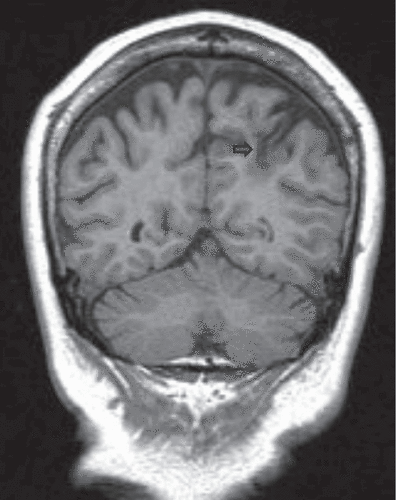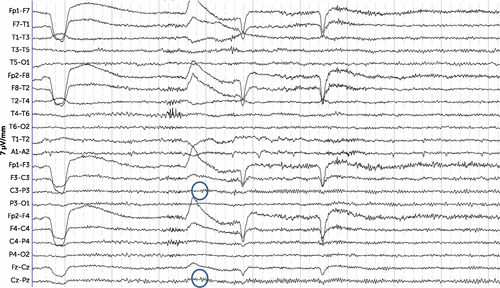Ictal Asomatognosia With Illusory Limb Movement Secondary to Dominant Parietal Lobe Lesion
To the Editor: Asomatognosia is a disorder of body awareness that is characterized by an individual’s unawareness or even denial of ownership of his or her body parts secondary to a brain disorder. A confabulatory response, including somatoparaphrenia or illusory limb movement, can be observed in some cases. These responses are mostly described in right hemisphere destructive lesions such as stroke.1,2
Asomatognosia as a result of seizure activity, or ictal asomatognosia, has been reported as a rare symptom of parietal lobe seizure, and asomatognosia is mostly seen in nondominant parietal lobe seizures.3,4 However, evidence of EEG correlates in ictal asomatognosia is not common in the literature.4 Ictal asomatognosia that is associated with a confabulatory response, especially illusory limb movement secondary to a dominant lobe lesion, has not been reported to date. Here we describe a rare case of ictal asomatognosia coupled with illusory limb movement and EEG correlates secondary to a dominant parietal lobe lesion, and we discuss the potential mechanism underpinning this phenomenon.
Case Report
A right-handed 74-year-old woman with a past medical history of hypertension presented to a tertiary hospital in Singapore, with complaints of episodic, intermittent right upper and lower limb “funny” sensations that she had for 3 days. Each episode typically lasted <5 minutes. The patient described the sensation of an inability to take control of her own limbs, stating that each limb “has [its] own mind.” She also reported sensations of limb movement during those episodes, with no observed physical movement. Neurologic examination results showed no definite motor or sensory deficits. A brain MRI scan showed a left parietal lobe lesion that was likely attributable to a previous hemorrhage (Figure 1). A 30-minute scalp EEG recording showed a total of four episodes of EEG seizures that arose from the left parietal region (20–25 Hz, maximum P3 and Pz) and lasted 40–70 seconds. The patient claimed that she felt “funny” and had twitches over her left arm and shoulder during one of the episodes (Figure 2). No movement was observed throughout the recording. The patient was prescribed levetiracetam, and the episodes completely resolved in a few days.

FIGURE 1. MRI Brain T1-Weighted Image Showing a Left Parietal Lobe Lesiona
a The MRI image shows a left parietal lobe lesion that is likely the result of a previous hemorrhage (arrow).

FIGURE 2. EEG Showing Onset of a Seizure Arising From the Left Parietal Regiona
a The EEG shows onset of a seizure (circles) arising from the left parietal region (20–25 Hz, maximum P3 and Pz). The patient reported that she felt “funny” and had twitches of the left arm and shoulder during the episode.
Discussion
Asomatognosia is more commonly described in patients with a lesion in the nondominant hemisphere. A wide range of severity has been described in the literature. For some patients, severity has been associated with a confabulatory nature toward their own limbs. Apart from denying ownership, some patients could even allocate a separate identity to their own limbs.1 Feinberg et al.2 described patients with confabulatory limb movement as having illusory limb movement. Among these, almost all are secondary to nondominant lobe lesions.
Geschwind5 proposed a disconnection model between the perceptual right and verbal left hemispheres as a cause of confabulatory asomatognosia observed in right hemisphere lesions. Gazzaniga6,7 also suggests that the left hemisphere serves an interpreter function, which constructs and interprets relationships between perceived events, actions, and feelings. On the basis of the above-mentioned studies, the left brain could potentially confabulate when there is an information gap between actions and perceptions.
Lu et al.8 showed that although illusory limb movement can be observed during left hemiparesis induced by right intracarotid barbiturate infusion, a clear link between anosognosia and phantom perception could not be demonstrated. Lu et al.8 suggested that anosognosia and phantom movement are dissociable. In our case, both confabulation and anosognosia occurred in the absence of hemiparesis; these combinations suggest that all three factors are likely not causative factors for each other, but they are possibly a product of miscommunication between the multiple regions across cerebral hemispheres. This is in line with a previous article by Venneri and Shanks,9 who proposed that deficits in multisensory integration and spatial representation of the body produce such observations.
Asomatognosia involving a dominant lobe has been uncommon to date. Nishibayashi et al.10 described a case of dominant lobe ictal asomatognosia with EEG correlates. Our case provides further evidence of ictal asomatognosia with EEG correlates, coupled with confabulatory illusory limb movement. Both cases highlight and support the hypothesis of a potential role of the dominant parietal lobe as the center of interpretation. A hyperfunctioning dominant parietal lobe as a result of a seizure could have created a mismatch between actions and senses, thus producing such semiology.
In conclusion, our case supports the previous disconnection model and reaffirms the possible role of the dominant parietal lobe in interpreting and integrating information on the limb’s senses and actions.
1 : Somatoparaphrenia: evolving theories and concepts. Cortex 2014; 61:74–80Crossref, Medline, Google Scholar
2 : Illusory limb movements in anosognosia for hemiplegia. J Neurol Neurosurg Psychiatry 2000; 68:511–513Crossref, Medline, Google Scholar
3 : Parietal lobe epilepsy. Clinical manifestations and outcome in 82 patients treated surgically between 1929 and 1988. Brain 1995; 118:607–627Crossref, Medline, Google Scholar
4 : Ictal asomatognosia as a cause of epileptic falls: simultaneous video, EMG, and invasive EEG. Neurology 2004; 63:2153–2154Crossref, Medline, Google Scholar
5 : Disconnexion syndromes in animals and man. II. Brain 1965; 88:585–644Crossref, Medline, Google Scholar
6 : The Social Brain: Discovering the Networks of the Mind. New York, Basic Books, 1985Google Scholar
7 : Cerebral specialization and interhemispheric communication: does the corpus callosum enable the human condition? Brain 2000; 123:1293–1326Crossref, Medline, Google Scholar
8 : Dissociation of anosognosia and phantom movement during the Wada test. J Neurol Neurosurg Psychiatry 2000; 69:820–823Crossref, Medline, Google Scholar
9 : Belief and awareness: reflections on a case of persistent anosognosia. Neuropsychologia 2004; 42:230–238Crossref, Medline, Google Scholar
10 : Ictal asomatognosia due to dominant superior parietal cortical dysplasia. J Clin Neurosci 2011; 18:141–142Crossref, Medline, Google Scholar



